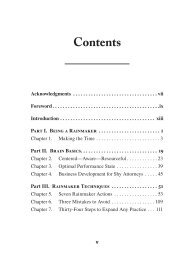(Bk Business) Carol Kinsey Goman Ph.D.-The Nonverbal Advantage_ Secrets and Science of Body Language at Work -Berrett-Koehler Publishers (2008)
Just
Just
Create successful ePaper yourself
Turn your PDF publications into a flip-book with our unique Google optimized e-Paper software.
118 <strong>The</strong> <strong>Nonverbal</strong> <strong>Advantage</strong><br />
“She keeps me <strong>at</strong> arm’s length.”<br />
Like facial expressions, h<strong>and</strong> gestures, <strong>and</strong> body postures,<br />
space speaks. And proxemics—the study <strong>of</strong> space as used in<br />
nonverbal communic<strong>at</strong>ion—says volumes about rel<strong>at</strong>ionships.<br />
People communic<strong>at</strong>e through the distances they maintain<br />
during encounters.<br />
TRY THIS<br />
At your next business meeting, notice who sits next to whom.<br />
Most <strong>of</strong> the time, people choose to sit near others they like <strong>and</strong><br />
agree with about the topic to be discussed. <strong>The</strong>y will also find<br />
ways to put distance between themselves <strong>and</strong> those they dislike.<br />
Sp<strong>at</strong>ial Zones<br />
A salesman was taking a client out to lunch, <strong>and</strong> by the time<br />
they’d finished their drinks <strong>at</strong> the bar, I knew the deal was<br />
lost. I w<strong>at</strong>ched the salesman move so close to his prospect<br />
th<strong>at</strong> the client began, very slowly, to inch away. When the<br />
client could st<strong>and</strong> it no longer, he excused himself to make a<br />
phone call—<strong>and</strong> left the restaurant shortly thereafter.<br />
One <strong>of</strong> the easiest mistakes to make during an encounter<br />
with someone is to misjudge how much space the other<br />
person needs to feel comfortable. A mistake here can trigger<br />
a truly deep-se<strong>at</strong>ed response. Anthropologist Edward T. Hall<br />
was one <strong>of</strong> the pioneers in the study <strong>of</strong> proxemics (in fact,<br />
he coined the word), <strong>and</strong> he found th<strong>at</strong> people’s territorial<br />
responses are deeply rooted <strong>and</strong> primitive. <strong>The</strong>y are also predictable—if<br />
you know wh<strong>at</strong> to look for.<br />
<strong>The</strong>re are five zones in which people feel most comfortable<br />
in dealing with one another. One way to think <strong>of</strong><br />
these is as a set <strong>of</strong> invisible bubbles we all carry with us into<br />
the workplace.




